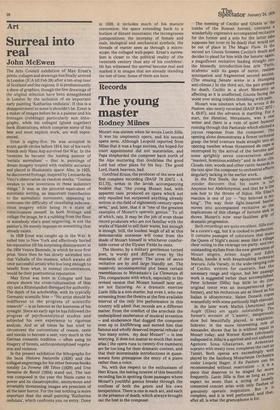Art
Surreal into real
John McEwen
The Arts Council exhibition of Max Ernst's prints, collages and drawings has finally arrived in London (ICA till Feb 29) after a ten-stop tour of Scotland and the regions. It is predominantly a show of graphics, though the few drawings of the original selection have been strengthened in London by the inclusion of an important early painting 'Katharine ondulata'. If this is a disappointment to some it shouldn't be. Ernst is a maker of images before he is a painter and his frottages (rubbings) particularly suit lithography, while his collaged (glued together) book illustrations, which comprise some of his best and most explicit work, are well represented.
Ernst is eighty-five. He was accepted in avant-garde circles before 1914, but of his early friends only Hans Arp survived the War. In the 'twenties he became the leading painter of 'veristic surrealism' — that is, paintings of dream imagery treated with realistic accuracy and placed in illusionistic space. Also, in 1925, he discovered frottage, inspired by Leonardo da Vinci's observation on random marks: "Genius awakes to new inventions in these indistinct things." It was, as the pictorial equivalent of automatic writing, an important contribution to the surrealistic movement, appearing to overcome the difficulty of visualising subconscious imagery while being in a state of consciousness oneself. In both frottage and collage the image, be it a rubbing from the floor or somebody else's steel engraving, is not the painter's. He merely imposes on something that already exists.
In 1939 Ernst was caught up in the War. It exiled him to New York and effectively buried his reputation till his surprising disinterment at the 1954 Venice Biennale, in which he woo first prize. Since then he has slowly ascended into that Valhalla of the masters, which awaits all once successful artists who live long enough to benefit from what, in normal circumstances, would be their posthumous reputation.
Max Ernst was born in Cologne and has always shown the cross-culturisation of that city and a Rhinelan dish disregard for authority. The depth of his scholarship, with its typically Germanic scientific bias — "No artist should be indifferent to the progress of scientific research" — is as famous as the keenness of his eyesight. Since an early age he has followed the progress of psychoanalytical studies and subjected his own experience to rigorous analysis. And at all times he has tried to circumvent the conventions of reason, taste and morals to become a seer, very much in the German romantic tradition often using its imagery of forests, anthropomorphised vegetation and violence.
In the present exhibition the lithographs for the book Histoire Naturelle (1926) and the collaged engravings for his other famous books notably La Femme 100 Tetes (1929) and Une Semaine de Bonte (1934) stand out. The last was composed in the year the Nazis came to power and its claustrophobic, anonymous and invariably threatening images are prescient of all the later horror. For the rest nothing is more important than the small painting 'Katharina ondulata', which confronts you on entry. Done in 1920, it includes much of his mature convention: the space extending back to a horizon of distant mountains; the incongruous juxtapositions; the interplay of female and male, biological and mechanical symbols; the threads of matter seen as through a microscope; the collaged wall-paper. Ernst's surrealism is closer to the political reality of the twentieth century than any of his confreres'. He has witnessed the surreal become real and marked it in images that are already standing the test of time. Some of them are here.


































 Previous page
Previous page